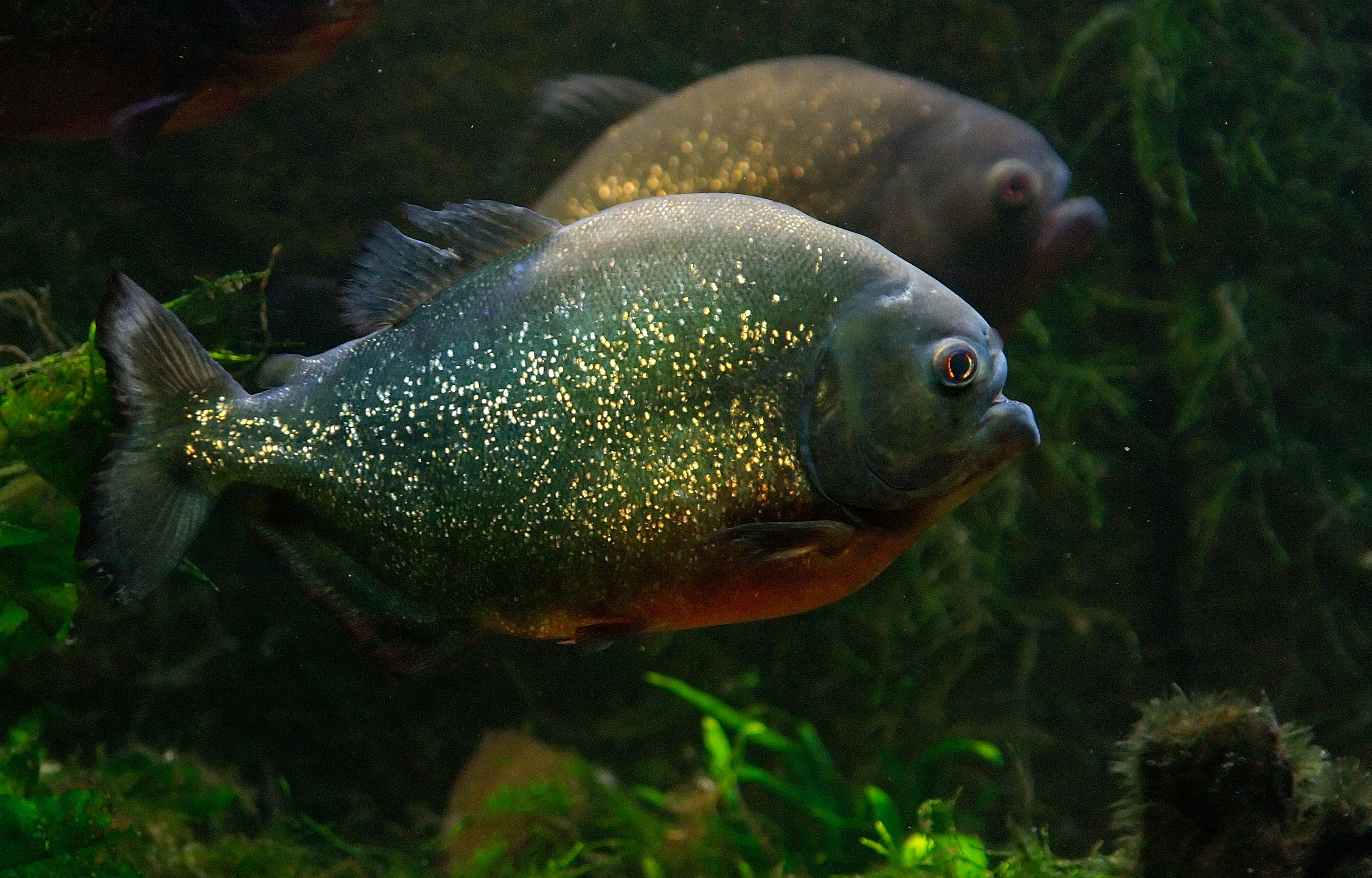- Red-bellied piranha
Taxobox
name = Red-bellied Piranha
status = LC

image_width = 250px
regnum =Animal ia
phyllum = chordata
classis =Actinopterygii
ordo =Characiformes
familia =Characidae
subfamilia =Serrasalminae
genus = "Pygocentrus "
genus_authority = Müller & Troschel, 1844
species = "P. nattereri"
binomial = "Pygocentrus nattereri"
binomial_authority = Kner,1858
synonyms = "Serrasalmus nattereri" (non Günther,1864 )The Red-bellied piranha ("Pygocentrus nattereri") is a
species ofpiranha . This species lives in theAmazon River Basin , coastal rivers of north-easternBrazil , and the basin of the Paraguay, Paraná andEssequibo River s. The red bellied piranha has the reputation for being one of the most ferocious freshwater fish in the world. They have a set of razor sharp teeth which are capable of stripping flesh from prey and dead animals. As their name suggests, they have a reddish tinge to the belly when fully grown, although juveniles are a silver colour with darker spots. They grow to a maximum length of 33 cm and a weight of 3.5 kg.Diet
Their diet consists mainly of fish, insects, worms and crustaceans but may sometimes eat large animals. The fish usually feed in large schools around dusk and dawn. They locate their prey by scent or motion using a set of sensors down the sides of the their bodies, called the lateral line system. This enables them to find struggling prey in murky water. The red belly has a set of teeth which will take triangular-shaped bites out of prey. Large schools will sometimes converge on large animals like
anacondas ,caimans , birds, and terrestrial mammals, stripping their bodies clean in a matter of minutes.Breeding
Red-bellied piranha usually spawn around April and May during the rainy season. The male will build a dug-out nest in rocks and vegetation awaiting a female. Females can lay around 6000 eggs which the male fertilizes. Males become extremely territorial during spawning, and will prevent other fish from approaching the nest. After the eggs hatch, both parents guard the brood. There are no notable differences in the appearance of males and females.
Red-bellied piranha in media
There are many myths surrounding this species. The 1978 film "Piranha" by
Joe Dante shows these fish in a similar light to "Jaws". "Piranha" was followed by a sequel, "", in 1981, and two remakes, one in 1995, and another which is forthcoming. Films such as these, and stories of large shoals of red bellies attacking humans, fuels the reputation of the red bellied piranha, being one of the most ferocious of all freshwater fish.In the aquarium
Piranha, despite their fearsome reputation, can be kept as aquarium fish. Their diet in nature consists of live prey and dead animals and fish. They readily eat other food as well, live feedings are not advised as they can introduce diseases. Red-bellied piranhas can grow to be 12" (30cm) long but they may eat any fish regardless of size. They may be kept with certain armoured catfish such as
Hypostomus plecostomus . Red bellied piranhas should be kept in small shoals of at least six individuals. These fish will sometimes bite one another in the aquarium, removing large chunks of flesh from the bitten fish. Providing any infections are treated, bitten individuals will usually make a full recovery, with little scarring. These fish are usually timid in the aquarium, due to the high light conditions and being in an enclosed environment as well as being in a shoal much smaller than in the wild. Some hobbyists have been disappointed with the fish's timidity in the aquarium. They require frequent water changes, with soft water. Extensive filtration is required. The tank should be kept at a pH of 5.5 to 7.0. Take care when cleaning the tank as a large piranha (usually docile and shy in an aquarium) is well capable of removing a chunk of flesh. Keep lights on when cleaning as the fish are more likely to bite in lighting similar to dusk. Furnish the aquarium with wood (mangrove root etc.) and robust plants ("Vallisneria " spp., "Microsorum pteropus ", "Anubias " spp., etc.).External links
* [http://fishbase.org/Summary/speciesSummary.php?ID=4501&genusname=Pygocentrus&speciesname=nattereri P. nattereri at FishBase]
* [http://www.opefe.com Oregon piranha exotic fish exhibit]
Wikimedia Foundation. 2010.
